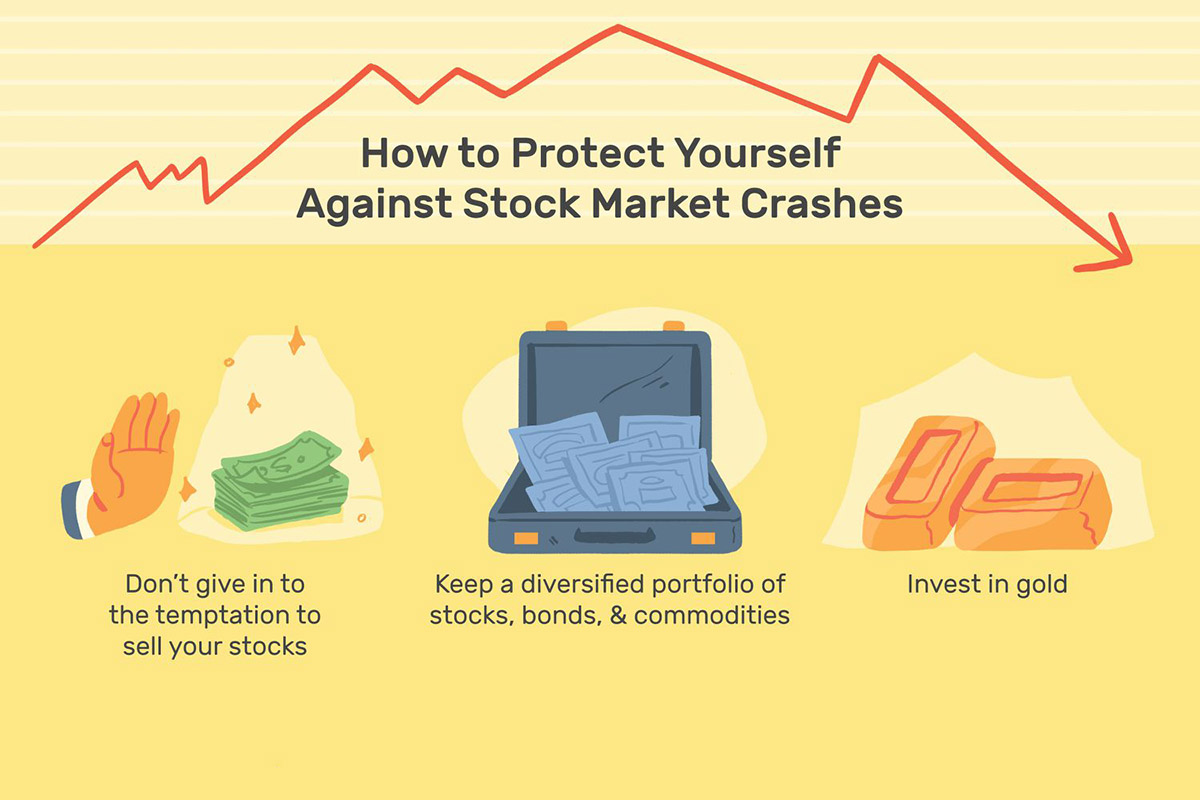

Finance
How To Bet Against The Stock Market
Published: October 20, 2023
Learn how to bet against the stock market and make strategic financial decisions. Enhance your finance skills and secure your investments with our expert tips and advice.
(Many of the links in this article redirect to a specific reviewed product. Your purchase of these products through affiliate links helps to generate commission for LiveWell, at no extra cost. Learn more)
Table of Contents
Introduction
The stock market is a fascinating and volatile arena where investors seek to make profits by buying shares of companies and selling them at a higher price. However, there are those who believe that the market is overvalued or heading towards a downturn, and they want to capitalize on this belief by betting against the stock market. In this article, we will explore the concept of betting against the stock market and the different strategies that can be employed to do so.
While many people associate investing with buying stocks and hoping for their value to increase, there is an alternative approach that involves betting against the stock market. Betting against the market essentially means taking a position that allows you to profit when stock prices decline. This approach is often used by experienced traders and financial professionals who have a deep understanding of market dynamics and are able to identify potential downside risks.
It’s important to note that betting against the stock market is not for the faint of heart or inexperienced investors. It requires a thorough understanding of market trends, an ability to analyze financial statements, and a strong stomach to weather the ups and downs of the market. Additionally, it’s worth mentioning that betting against the stock market is a speculative strategy and involves a higher level of risk compared to traditional long-term investing.
So why would someone want to bet against the stock market? There are several reasons that may motivate investors to take this stance. First, they may have a negative perception of the overall economic conditions and believe that a market downturn is imminent. Second, they may have identified specific companies or sectors that they believe are overvalued and due for a correction. Lastly, some investors may simply want to diversify their portfolio and hedge against potential losses in the stock market.
In the next sections, we will explore the different types of stock market bets that can be placed to bet against the market. These strategies include short selling, put options, and inverse exchange-traded funds (ETFs). Each strategy has its own unique characteristics and risk factors, so it’s important to thoroughly understand them before implementing them in your investment approach.
Understanding the Stock Market
Before delving into the strategies for betting against the stock market, it’s essential to have a clear understanding of how the stock market operates. At its core, the stock market is a marketplace where buyers and sellers trade shares of publicly listed companies. These shares represent ownership in a company and are bought and sold with the aim of making a profit.
The stock market provides a platform for companies to raise capital by issuing shares to investors in exchange for funds. Investors, on the other hand, have the opportunity to profit from the growth of these companies by buying their shares and holding them for a period of time. The value of a company’s shares is determined by various factors, including its financial performance, industry outlook, and overall market sentiment.
Stock markets operate on the principle of supply and demand. When there is high demand for a particular stock, its price tends to increase. Conversely, when there is more supply than demand, the price tends to decrease. These fluctuations in stock prices can be caused by a multitude of factors, including economic conditions, political events, and company-specific news.
Stock markets can be categorized into two main types: primary and secondary markets. The primary market is where newly issued shares are bought and sold in initial public offerings (IPOs). Once the shares are listed on a stock exchange, they can be traded on the secondary market. The primary stock exchanges, such as the New York Stock Exchange (NYSE) and NASDAQ, play a vital role in facilitating the trading of shares.
Investors in the stock market can take two main approaches: long-term investing and short-term trading. Long-term investing involves buying shares of companies with the intention of holding them for an extended period, typically several years or more. Long-term investors rely on the growth and profitability of the companies they invest in to generate returns over time.
On the other hand, short-term traders aim to profit from short-term price movements in the market. These traders may buy and sell shares within a matter of hours or days, taking advantage of market volatility and quick price fluctuations. Short-term trading requires active monitoring of the market and the ability to make decisions based on technical and fundamental analysis.
Having a solid understanding of how the stock market operates is crucial when considering strategies to bet against it. By gaining insights into market dynamics, investor behavior, and economic indicators, you’ll be better equipped to identify opportunities for betting against the market and potentially profit from downturns in stock prices.
Why Bet Against the Stock Market?
Betting against the stock market may seem counterintuitive to some, especially considering the long-standing idea of investing for long-term growth. However, there are several reasons why some investors choose to take a contrarian approach and bet against the market. Let’s explore some of these reasons.
First, some investors bet against the stock market because they believe that it is overvalued or in a bubble. They analyze economic indicators, market trends, and company valuations to form a negative outlook. This perspective suggests that stock prices have reached unsustainable levels and are due for a correction. By betting against the market, these investors aim to profit from the potential decline in stock prices.
Second, betting against the stock market allows investors to hedge their portfolio against potential losses. Even the most seasoned investors cannot accurately predict market movements all the time. By placing bets against the market, investors can offset potential losses from their long positions in case of a market downturn. This hedging strategy can provide a degree of protection and help manage risk.
Another reason to bet against the stock market is to capitalize on specific companies or sectors that are perceived to be overvalued. Investors who have conducted thorough research and analysis may identify companies with inflated stock prices relative to their true value. By betting against these specific stocks, they can potentially profit from a decline in their prices when the market eventually corrects itself.
Moreover, some investors bet against the stock market due to macroeconomic concerns or geopolitical uncertainties. Economic indicators such as GDP growth, inflation rates, and unemployment numbers can influence investor sentiment. If investors have a negative outlook on the economy or anticipate a recession, they may choose to bet against the market to profit from a decline in stock prices during difficult economic times.
It’s important to note that betting against the stock market is a speculative strategy and carries higher risks compared to traditional long-term investing. Timing the market accurately is challenging, and even seasoned investors can make mistakes. It requires extensive research, analysis, and a firm understanding of market dynamics. Therefore, it’s crucial for investors to thoroughly assess the risks and have a clear strategy before embarking on betting against the stock market.
In the next sections, we will explore different types of stock market bets that investors can utilize to bet against the market. These strategies include short selling, put options, and inverse exchange-traded funds (ETFs). Each strategy offers its own advantages and considerations, allowing investors to choose the approach that aligns with their risk tolerance and investment objectives.
Types of Stock Market Bets
When it comes to betting against the stock market, there are several strategies that investors can employ. These strategies allow investors to profit from a decline in stock prices or hedge against potential losses. Let’s explore the three main types of stock market bets: short selling, put options, and inverse exchange-traded funds (ETFs).
1. Short Selling:
Short selling is a popular strategy used by investors to bet against a specific stock or the overall market. In short selling, investors borrow shares from a broker and sell them in the open market, with the aim of buying them back at a lower price in the future. If the price of the stock drops as expected, investors can repurchase the shares at a lower price, return them to the broker, and pocket the difference as profit. Short selling can be profitable when the market is in a downtrend, but it carries high risks as the potential losses are unlimited if the stock price increases.
2. Put Options:
Put options are financial derivatives that give investors the right, but not the obligation, to sell a specific stock at a predetermined price (the strike price) within a specified timeframe. By purchasing put options, investors can profit if the price of the underlying stock decreases below the strike price. Put options provide a more controlled risk compared to short selling, as the investor’s losses are limited to the premium paid for the options. However, it’s important to note that if the stock price does not drop below the strike price within the specified timeframe, the option may expire worthless, resulting in a loss of the premium paid.
3. Inverse ETFs:
Inverse exchange-traded funds (ETFs) are designed to provide the opposite return of a specific index or sector. These ETFs use various financial derivatives and strategies to achieve a negative correlation to the market. By investing in inverse ETFs, investors can profit from a decline in the market or a specific sector without short selling individual stocks. Inverse ETFs offer a more straightforward and accessible way for investors to bet against the market, but it’s important to carefully evaluate the fund’s performance, expense ratios, and risks associated with tracking errors.
Each of these stock market betting strategies has its own advantages and considerations. The choice of strategy depends on an investor’s risk tolerance, investment objectives, and understanding of market dynamics. It’s crucial for investors to thoroughly research and analyze each strategy before implementing them in their portfolio.
In the next sections, we will delve deeper into each strategy, exploring how they work, risks involved, and key considerations to keep in mind. Understanding these strategies will allow investors to make informed decisions and effectively bet against the stock market when appropriate.
Short Selling
Short selling is a strategy used by investors to bet against a specific stock or the overall market. It involves borrowing shares from a broker and selling them in the open market, with the expectation that the price of the stock will decline. If the stock price decreases as anticipated, the investor can repurchase the shares at a lower price, return them to the broker, and profit from the difference.
To engage in short selling, an investor needs to have a margin account with a brokerage firm. The broker lends the shares to the investor, who then sells them on the exchange. The investor must eventually repurchase the shares to close their position and return them to the broker. Short selling can be a useful strategy in a declining or bearish market, as it allows investors to profit from falling stock prices.
However, short selling carries higher risks compared to traditional long positions. The potential losses in short selling are theoretically unlimited, as there is no upper limit to how high a stock price can go. If the stock price increases instead of decreasing, the investor may face significant losses. It is crucial to carefully manage risk and set stop-loss orders to limit the potential losses if the trade goes against the investor.
Short selling also comes with certain considerations and limitations. It’s important to keep in mind that short selling involves borrowing shares, so there may be borrowing costs or interest charges associated with the position. Additionally, not all stocks are available to be shorted, as some may have limited availability or restrictions from the brokerage. Investors need to research and ensure that the stocks they wish to short are easily accessible.
Another factor to consider when short selling is the potential for a short squeeze. A short squeeze occurs when there is a sudden increase in demand for a stock that has a significant number of short positions. This increased demand can lead to a rapid rise in the stock price as short sellers rush to cover their positions by repurchasing shares, creating further buying pressure in the market. Traders need to be cautious of potential short squeezes and manage their positions accordingly.
Overall, short selling can be a profitable strategy for experienced investors who have a thorough understanding of the risks involved. It requires careful analysis, market timing, and risk management. It’s important to have a clear exit strategy and closely monitor the position to protect against potential losses. Short selling should be approached with caution and utilized by investors who have the knowledge and experience to navigate the complexities of the market.
Put Options
Another strategy for betting against the stock market is through the use of put options. Put options are financial derivatives that give investors the right, but not the obligation, to sell a specific stock at a predetermined price within a specified timeframe. By purchasing put options, investors can profit if the price of the underlying stock decreases below the strike price.
To understand how put options work, consider this example: let’s say an investor believes that the price of Company XYZ stock, currently trading at $50, will decline in the next month. The investor can purchase a put option with a strike price of $45 and an expiration date one month from now. If the stock price indeed drops below $45 before the expiration date, the investor can exercise the put option, selling the stock at the higher strike price and profit from the difference.
Put options provide investors with a degree of flexibility and control. Investors can limit their potential losses to the premium paid for the options, as they are not obligated to exercise the options if the stock price does not decrease as anticipated. This makes put options a more controlled risk strategy compared to short selling, where the potential losses can be unlimited.
It’s important to note that purchasing put options requires careful consideration of several factors. The premium price of put options can be significant, especially for stocks with higher levels of volatility. Investors need to assess whether the potential profit from the stock price decline justifies the cost of the options. Additionally, the expiration date of the options should align with the investor’s timeframe for the anticipated stock price decline.
When trading put options, it’s essential to have a good understanding of the options market and related concepts such as implied volatility, delta, and theta. These factors can impact the pricing and performance of put options. Investors should also consider the liquidity of the options contracts, as low liquidity can lead to wider bid-ask spreads and potentially impact trade execution.
It’s important to remember that put options involve risk, and they may expire worthless if the stock price remains above the strike price at expiration. Investors need to carefully evaluate their risk tolerance and have a clear exit strategy when trading put options. It is often recommended to consult with a financial advisor or options specialist before engaging in options trading to ensure a thorough understanding of the risks and the appropriate use of these derivatives.
Put options can be a powerful tool for investors looking to bet against the stock market or hedge their existing positions. They offer potential opportunities to profit from declining stock prices while limiting potential losses. However, like any investment strategy, investors should conduct thorough research and understand the risks involved before utilizing put options in their portfolio.
Inverse ETFs
Inverse exchange-traded funds (ETFs) are a type of investment vehicle that allows investors to bet against the stock market or specific sectors without short selling individual stocks. These ETFs are designed to provide the opposite return of a specific index or sector by utilizing various financial derivatives and strategies.
Inverse ETFs work by employing techniques such as short selling, futures contracts, and options to achieve a negative correlation to the target index or sector. For example, an inverse ETF that tracks the S&P 500 index aims to generate returns that are inversely proportional to the performance of the index. So, if the S&P 500 declines by 10%, the inverse ETF would aim to increase by 10%.
Inverse ETFs offer a more accessible and straightforward way for investors to bet against the market compared to short selling or options trading. They can be bought and sold throughout the trading day, providing investors with liquidity and the ability to exit positions quickly if needed. Additionally, inverse ETFs allow investors to gain exposure to a broad market or sector decline without having to select and manage individual short positions.
It’s important to note that inverse ETFs are not designed for long-term holding. They are primarily intended for short-term trading or hedging purposes due to the structure and potential risks involved. Inverse ETFs aim to provide daily inverse returns to the target index or sector, which means their performance may not perfectly reflect the inverse movement over an extended timeframe. Therefore, they may not be suitable for long-term investments or buy-and-hold strategies.
Investors should also consider the expenses and tracking errors associated with inverse ETFs. These funds often have higher expense ratios compared to traditional ETFs due to the operational costs involved in implementing inverse strategies. Additionally, tracking errors may occur as the inverse performance may deviate slightly from the target index or sector. It’s important to assess the fund’s historical performance and compare it to the intended inverse exposure to evaluate the effectiveness of the fund.
Lastly, like any investment, inverse ETFs come with inherent risks. As with all investments in the stock market, there is a potential for loss of capital. Investors should carefully consider their risk tolerance and understand that inverse ETFs may experience periods of volatility. Proper risk management, including using stop-loss orders and diversifying among different asset classes, is crucial when utilizing inverse ETFs in a portfolio.
Inverse ETFs can be an effective tool for investors looking to bet against the stock market or hedge their existing positions. They provide a convenient way to gain inverse exposure to a broad market or sector without the complexities of short selling or options trading. However, investors should thoroughly research and understand the risks and features of inverse ETFs before incorporating them into their investment strategies.
Timing the Market
Timing the market is a strategy that involves attempting to predict the future movements of the stock market in order to make buy or sell decisions. Investors who engage in market timing believe they can accurately anticipate market trends and capitalize on opportunities to profit or protect their investments. However, timing the market can be a challenging and risky endeavor.
One approach to market timing is to identify periods when the market is likely to experience a downturn or correction and adjust investment allocations accordingly. This may involve reducing exposure to stocks and increasing holdings in cash or other defensive assets. Similarly, investors may try to take advantage of market upswings by increasing their stock holdings during periods of expected growth.
The challenge with timing the market lies in accurately predicting the timing of market movements. Even seasoned investors and financial experts struggle to consistently time the market with accuracy. Market timing requires not only a deep understanding of economic indicators, company valuations, and market psychology, but also a bit of luck.
Timing the market successfully involves making two critical decisions: when to sell and when to buy back into the market. Selling too early may result in missed gains if the market continues to rise, while selling too late may lead to significant losses in the event of a market downturn. Similarly, buying back into the market too early may result in buying at elevated prices, and waiting too long may cause investors to miss out on potential returns.
It’s worth noting that market timing is a short-term trading strategy and differs from long-term investing. Long-term investors tend to focus on the overall growth potential of their investments and take advantage of compounding returns over time. Market timing, on the other hand, aims to profit from shorter-term market fluctuations and requires a more active and involved approach.
Investors considering market timing should carefully evaluate their risk tolerance and investment goals. They should also be aware of the potential tax implications and trading costs associated with frequent buying and selling. In addition, market timing requires constant monitoring of the market, economic factors, and company-specific news, which can be time-consuming and stressful.
Timing the market is a speculative approach that involves inherent risks. Even experts in the field find it challenging to consistently time the market accurately. For most investors, a more prudent approach may be to focus on a long-term investment strategy based on fundamental analysis, diversification, and a disciplined approach to asset allocation. By staying invested in the market over the long run, investors can potentially benefit from the inherent growth of the economy and the performance of the stock market.
Ultimately, the decision to engage in market timing or adopt a long-term investment strategy depends on an individual investor’s goals, risk tolerance, and confidence in their ability to accurately time the market. It’s important to carefully consider the potential risks and rewards associated with timing the market and consult with a financial advisor if needed.
Risks and Considerations
Betting against the stock market entails certain risks and considerations that investors should be aware of before implementing such strategies. While these strategies can potentially offer opportunities for profit, they also come with inherent challenges and potential downsides. Here are some key risks and considerations to keep in mind:
1. Market Volatility:
The stock market is inherently volatile, and betting against it amplifies the potential for volatility. Prices can fluctuate significantly in a short period, and sudden market movements can lead to unexpected losses. Investors need to be prepared for the potential swing in prices and the emotional toll that can come with it.
2. Timing Challenges:
Timing the market accurately is a challenging task. Even experienced investors and experts struggle to consistently predict market movements. Being consistently accurate in timing trades is highly unlikely, and mistimed moves can result in significant losses. It is crucial to recognize the limitations of market timing and be realistic about the success rate.
3. Limited Downside Protection:
When betting against the stock market, the potential for losses is theoretically unlimited. This is especially true in strategies like short selling, where stock prices can rise indefinitely. Investors must be mindful of potential losses and utilize risk management techniques, including stop-loss orders and position sizing, to protect their capital.
4. Research and Analysis:
Successful betting against the stock market requires diligent research and analysis. It involves understanding company fundamentals, market trends, and economic indicators. Investors need to be adept at gathering and analyzing information and making informed decisions based on thorough research.
5. Effects of Leverage:
Some strategies, such as short selling and options trading, can involve the use of leverage. While leverage can amplify potential profits, it also intensifies risks. Investors need to exercise caution when utilizing leverage and be prepared for the potential magnification of losses in case of adverse market movements.
6. Psychological Factors:
Betting against the stock market requires a strong mindset and emotional discipline. Market downturns and losses can induce fear and uncertainty, potentially leading investors to make irrational decisions or exit their positions prematurely. It is crucial to be emotionally prepared and maintain a long-term perspective when engaging in strategies against the stock market.
Considering these risks and considerations, it is vital for investors to carefully assess their risk tolerance, investment objectives, and level of experience before engaging in betting against the stock market. Diversification, proper risk management, and a long-term investment focus remain key principles to mitigate risks and achieve overall portfolio success.
Conclusion
Betting against the stock market can be an enticing strategy for investors who believe in the potential for profit from declining prices or seek to hedge against market downturns. However, it is vital to approach these strategies with caution and a thorough understanding of the risks involved. Short selling, put options, and inverse ETFs are all viable methods to bet against the stock market, but they require diligent research, analysis, and risk management.
While these strategies offer potential opportunities for profit, they come with inherent risks. Market volatility, timing challenges, limited downside protection, the need for intensive research, the effects of leverage, and psychological factors all play a role in the success of these strategies. Investors must carefully evaluate their risk tolerance and investment goals before implementing such strategies.
It’s important to remember that betting against the stock market is a speculative approach and should be approached with proper knowledge and experience. It is highly recommended that investors seek the guidance of a financial advisor or investment professional to navigate the complexities of these strategies and ensure that they align with their overall investment objectives.
Ultimately, successful investing involves a balanced approach that considers both long-term growth opportunities and short-term speculative strategies. By diversifying their portfolios and having a disciplined investment approach, investors can mitigate risks and potentially achieve their financial goals.
In conclusion, betting against the stock market can be a lucrative strategy for experienced investors, but it requires careful consideration, thorough research, and a disciplined approach. It is essential to understand the risks involved and to properly manage these risks through diversification and risk mitigation techniques. By doing so, investors can navigate the markets with confidence and aim to profit from potential market downturns.














